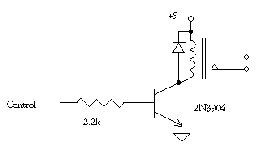James Newton
2008-05-19 00:42:51 UTC
Ok, first, let me just remind everyone that I'm almost totally clueless when
it comes to analog electronics. Years ago, I took classes in the Navy on
transistors and I sort of understood it... back then...
I'm trying to drive a small 5 volt relay from a pin on a PC parallel port.
The circuit I'm trying is right out of the PICList archive / FAQ at:
http://www.piclist.com/techref/io/relays.htm more specifically at
Loading Image... but it is for a PIC, not the
but it is for a PIC, not the
PC parallel port, and certainly not for nStrobe, which is one of the weaker
lines on the port. This is probably the cause of my troubles, but I don't
know how to fix it. The attached is the actual circuit.
RELAY: OMRON G5LE-1 DC5 According to the datasheet:
https://www.jameco.com/Jameco/Products/ProdDS/187151.pdf it has a coil
resistance of 63 Ohms. I have a 1N4148 connected backward over the coil to
prevent kick back.
PC: Parallel Port pin 1: nStrobe is the line that I need to use to drive
this relay. It is supposed to be driven, in the parallel port hardware, by
the equivalent of a 7405 inverting open collector buffer, pulled to +5 volts
via a 4.7K resistor.
http://www.piclist.com/techref/io/parallel/signals.htm
I have a 2N3904 transistor with the emitter connected to ground, the base to
the nStrobe signal from the PC parallel port and the collector is connected
to the relay coil. The other end of the coil is connected to +5VDC.
When the nStrobe line is not connected to the circuit, using a program on
the PC to toggle the pin, I can get 0.009 - 5.07 VDC on the pin as read by
my multi-meter.
When the circuit is connected, and powered up, I get 0.010 - 0.657 VDC and
the relay does not close.
I attached a potentiometer between the base an +5 and turned it until the
relay just activated, then backed it off and tried toggling the nStrobe
line. At that point I was able to control the relay from the PC port, but
removing the pot and measuring its value showed that it was 203Ohms. Not K
Ohms; Ohms. That ain't going to cut it.
The parallel port appears undamaged. The relay and transistor do switch and
the power supply seems to work ok, but 200 Ohms cannot possibly be ok. I
don't understand how that failed to destroy the port... My old PC must have
some sort of current limiting built in.
I had previously been advised (thank you friend) that I might have better
luck in a different configuration using a BC337-40, but that was a different
circuit entirely. The point of this new circuit is to avoid the extra cost
of the more dear transistor. If I have to use it, so be it, but since I'm
totally clueless, I figured I should ask for help before trying anything
more.
HELP?
James Newton: PICList webmaster/Admin
mailto:jamesnewton-***@public.gmane.org 1-619-652-0593 phone
http://www.piclist.com/member/JMN-EFP-786
PIC/PICList FAQ: http://www.piclist.com
it comes to analog electronics. Years ago, I took classes in the Navy on
transistors and I sort of understood it... back then...
I'm trying to drive a small 5 volt relay from a pin on a PC parallel port.
The circuit I'm trying is right out of the PICList archive / FAQ at:
http://www.piclist.com/techref/io/relays.htm more specifically at
Loading Image...
PC parallel port, and certainly not for nStrobe, which is one of the weaker
lines on the port. This is probably the cause of my troubles, but I don't
know how to fix it. The attached is the actual circuit.
RELAY: OMRON G5LE-1 DC5 According to the datasheet:
https://www.jameco.com/Jameco/Products/ProdDS/187151.pdf it has a coil
resistance of 63 Ohms. I have a 1N4148 connected backward over the coil to
prevent kick back.
PC: Parallel Port pin 1: nStrobe is the line that I need to use to drive
this relay. It is supposed to be driven, in the parallel port hardware, by
the equivalent of a 7405 inverting open collector buffer, pulled to +5 volts
via a 4.7K resistor.
http://www.piclist.com/techref/io/parallel/signals.htm
I have a 2N3904 transistor with the emitter connected to ground, the base to
the nStrobe signal from the PC parallel port and the collector is connected
to the relay coil. The other end of the coil is connected to +5VDC.
When the nStrobe line is not connected to the circuit, using a program on
the PC to toggle the pin, I can get 0.009 - 5.07 VDC on the pin as read by
my multi-meter.
When the circuit is connected, and powered up, I get 0.010 - 0.657 VDC and
the relay does not close.
I attached a potentiometer between the base an +5 and turned it until the
relay just activated, then backed it off and tried toggling the nStrobe
line. At that point I was able to control the relay from the PC port, but
removing the pot and measuring its value showed that it was 203Ohms. Not K
Ohms; Ohms. That ain't going to cut it.
The parallel port appears undamaged. The relay and transistor do switch and
the power supply seems to work ok, but 200 Ohms cannot possibly be ok. I
don't understand how that failed to destroy the port... My old PC must have
some sort of current limiting built in.
I had previously been advised (thank you friend) that I might have better
luck in a different configuration using a BC337-40, but that was a different
circuit entirely. The point of this new circuit is to avoid the extra cost
of the more dear transistor. If I have to use it, so be it, but since I'm
totally clueless, I figured I should ask for help before trying anything
more.
HELP?
James Newton: PICList webmaster/Admin
mailto:jamesnewton-***@public.gmane.org 1-619-652-0593 phone
http://www.piclist.com/member/JMN-EFP-786
PIC/PICList FAQ: http://www.piclist.com